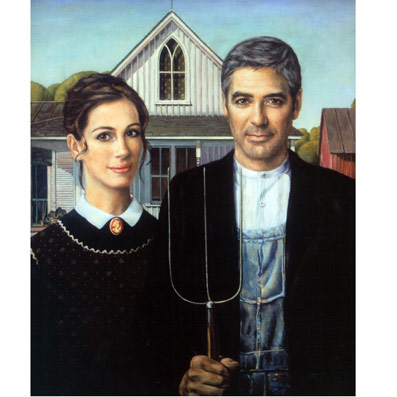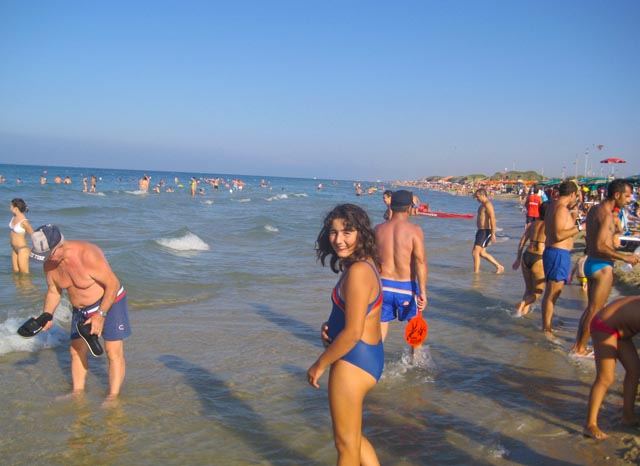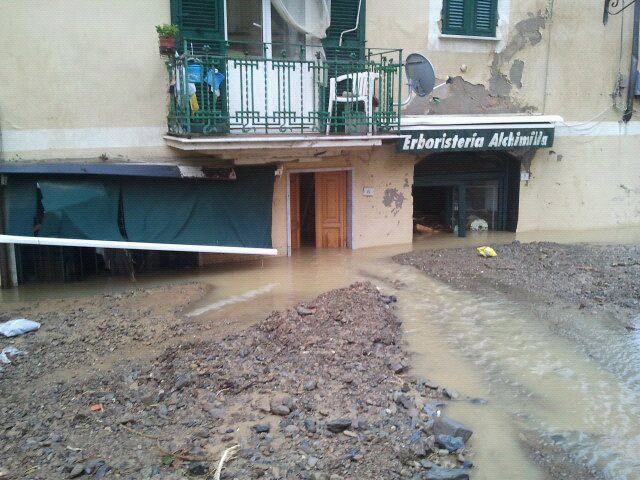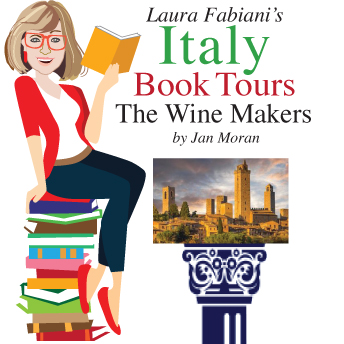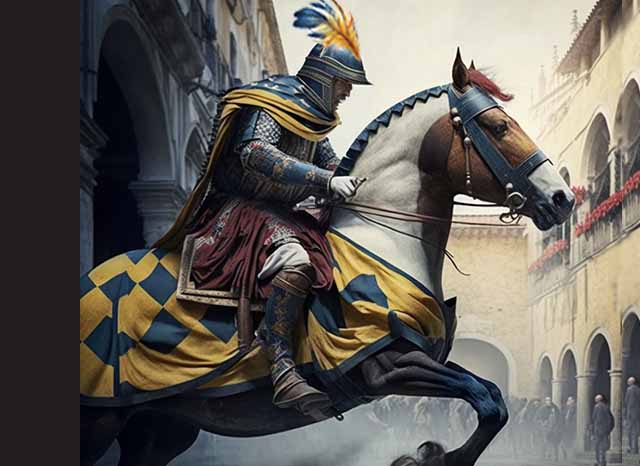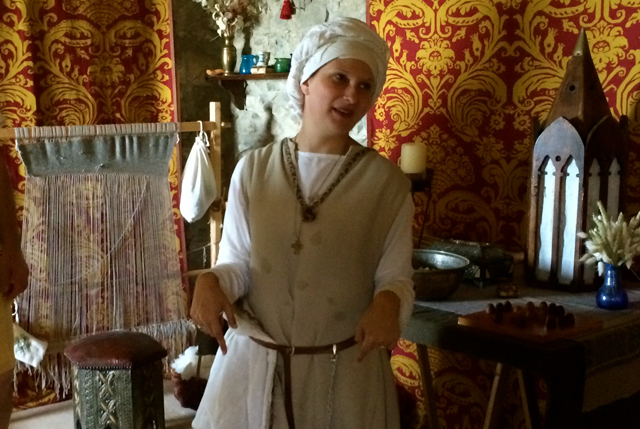
Recently I posted and recorded a podcast about the very interesting Fortezza della Verrucole. The fortress sits high on top of a hill located in the Garfagnana Valley and is now home to an Archeopark; its mission is to teach visitors more about daily medieval life. Every day, the fortress’s curators dress in period costumes and demonstrate to visitors what reality was like, both the beautiful and the ugly, without frills or artifice.
They are a passionate dedicated group of individuals who have studied the fortress’s history, as well as the medieval customs and traditions, are now painstakingly restoring it using methods and practices that would have been common during the medieval ages. In a follow-up guest post-Giulia Paltrinieri, whose voice you also hear in the podcast, explains more about the fortress, talks about medieval life, and clarifies some historical points touched upon in the podcast. In this post, she also provides additional resources for readers who are interested in learning more about the fortress and the medieval time period.
To listen to the podcast click here
Dal blog di Melissa traspare un entusiasmo a dir poco contagioso e siamo orgogliosi della sua scelta di dedicare alla Fortezza delle Verrucole e al nostro Acrheopark al suo interno queste pagine virtuali. Le ringraziamo di averci concesso uno spazio come ospiti sul suo blog per poter scrivere anche noi qualche riga di precisazioni storiche sulla Fortezza e sulla nostra attività di Living History al suo interno.
From Melissa’s blog transpires an enthusiasm that is nothing short of contagious and we are proud of her decision to dedicate a post to the Verrucole Fortress and our Acrheopark. We thank her also for giving us the opportunity to write a guest post to clarify a few historical details about the fortress and the work we do to promote the living history that we do inside the walls of the fortress.
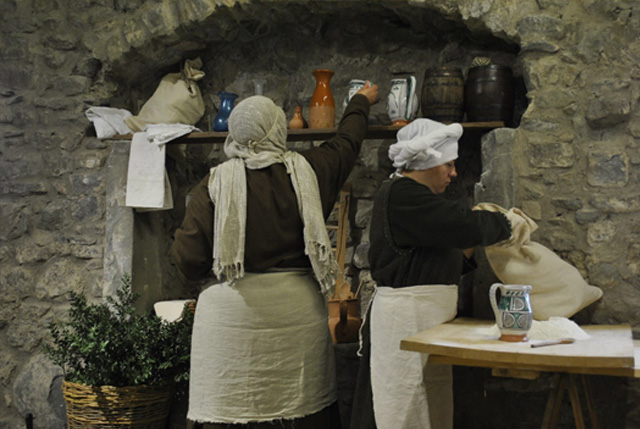
Questo perché ci rendiamo conto che nel articolo e nel podcast precedente la nostra visitatrice non poteva certo essere troppo tecnica per non essere troppo didattica e quindi questa è un opportunità di spiegare alcuni fatti storici della fortezza. Per questa ragione dedichiamo il nostro tempo e energia a dissipare malintesi del periodo medievale.
We realize that in the previous post and podcast our visitor could not get too technical and so this is an opportunity for us to more precisely explain some historical aspects of the fortress. It is sometimes hard to view the past based through modern eyes. For this reason, we dedicate our time and energy to dispel misconceptions of the medieval period.
Quando si parla di storia, il pericolo degli assoluti è una spada di Damocle onnipresente… I libri scolastici stessi, hanno creato alcuni preconcetti sul medioevo che in età adulta andrebbero approfonditi e rivisti. Ad esempio, il sistema di vassallaggio che tanto abbiamo ben memorizzato da bambini. Esso non è mai stato infatti attuato nella toscana medievale, caratterizzata da un sistema di città-stato a ordinamento repubblicano, per esempio Siena, Lucca, Pisa, Firenze. Ma, proprio perché come si suol dire “non si può fare di tutta l’erba un fascio”, è anche vero che il sito di Verrucole ha rappresentato uno dei pochissimi casi di feudalesimo in quella toscana medievale dei liberi comuni.
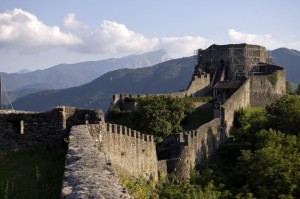
When it comes to history, the danger of absolutes is a sword of Damocles ubiquitous. School books themselves, have created some preconceptions about the Middle Ages that in adulthood should be explored and reviewed. For example, take for example the system of vassalage we learned as children. It was never in fact implemented in medieval Tuscany, which instead was characterized by a system of republican city-states, for instance, think of Siena, Lucca, Pisa, Florence. But, because as they say “you can not do all the same brush” / “or there are always exceptions to the rule”, it is also true that the Fortress of the Verrucole was one of the very few cases of feudalism found amongst the free medieval Tuscan communities.
Che la vita nel medioevo fosse dura è innegabile, ma non più che in secoli più vicini al nostro. Imperavano sicuramente la parsimonia e la modestia: certo, si avevano pochi abiti, ma non per povertà o scelta, bensì perché erano frutto di un lavoro completamente artigianale, che non poteva essere rovinato o sprecato, bensì riadattato e rispettato (l’abito della festa è un concetto che abbiamo ancora oggi!).
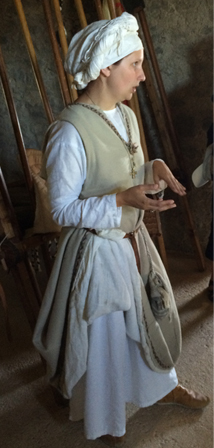
Life in the Middle Ages was indeed difficult. That is undeniable, but no more than in previous centuries. Certainly, there was a trend toward thriftiness and modesty: yes, there were few clothes, but not because of poverty or choice, but because all clothes were of completely handmade work, which was time-consuming and so particular care was taken not to spoil or waste clothes, but rather clothes were even more appreciated, cared for and highly regarded. Dressing up for parties is a concept that we still embrace and this comes from the medieval period!
Ovviamente, le condizioni igieniche non erano le nostre ma erano adatte alla fisiologia dell’epoca sicuramente più abituata e resistente; e l’assenza di antibiotici che a noi spaventa tanto era almeno in parte sostituita dall’applicazione della medicina naturale che è madre della medicina moderna. L’alimentazione era semplicemente diversa; addirittura, quello che può sembrare un “marchio di povertà”, ovvero l’alimentazione contadina legata più ai prodotti della terra che al consumo di carni in realtà portava ad uno stile di vita più sano.
Obviously, the hygienic conditions were not like ours, but they were suited to the physiology of the time and certainly, personal care was attended to habitually; and the absence of antibiotics that scares us so much today, was for the most part effectively substituted by the application of natural medicine, that is after all the mother of modern medicine. The food supply was simply different; what may seem to us as a “mark of poverty,” as in the case of peasants who ate the vegetables of the earth, products of the earth rather than meat, was in fact, the basis of a much healthier lifestyle.
Quel medioevo fantastico e romantico uscito dalla penna di autori come Scott o Goethe, così ben descritto dalla nostra blogger Melissa ha in realtà delle radici vere e proprie nella letteratura medievale (ad es., Il ciclo carolingio o quello Arturiano) e nel folklore stesso, popolato di fate, eroi e romanticismo. Questo perché il desiderio di sognare staccandosi dalla realtà è insito nella natura umana. Il mondo reale è sempre stato meno fiabesco dell’immaginazione in qualunque secolo e la società medievale non era certo esente da questi sogni di evasione. Potremmo forse arrivare a dire che quel mondo di sentimenti e eroismi sia addirittura più realistico del grigiume con cui il cinema contemporaneo dipinge la collettività medievale, perché ne esalta pulsioni e aspirazioni. Si trattava sicuramente di una società imbrigliata in rigide categorie e ruoli sociali, ma questo non ne ha sicuramente mai spento l’umanità.
The romanticized idea that the Medieval period was quaint and charming came not only from Scott or Goethe, as so well described by our blogger Melissa, but also has its true romantic roots in medieval literature itself (eg., The Charlemagne Cycle or the legends of King Arthur), as well as in the folklore of the time that was populated by fairies, heroes and romance. This is because the desire to dream or break away from reality is inherent in human nature. The real world has always been less romantic so in any era, as in medieval society, it was common to escape through daydreams and romantic writings. We could say that contemporary depictions of medieval heroism and sentiments are even more realistic in the grayness in which contemporary cinema paints medieval life because it becomes a catalyst that fuels aspirations. It was definitely a society entangled in rigid casts and social roles, but none of that extinguished humanity.
Il nostro scopo col progetto di Archeopark alla Fortezza delle Verrucole esplora quanto detto sinora. Giorno per giorno, cerchiamo di far vedere ai nostri visitatori la realtà così com’era, nel suo bello e nel suo brutto, senza fronzoli o artifizi. Nella nostra storia cerchiamo di trovare trovare in nuce (anche a livello linguistico) le origini di ciò che siamo oggi. Alcuni esempi concreti? Invenzioni tanto banali quanto rivoluzionarie: il letto, gli occhiali, la forchetta, nati tutti proprio nel medioevo. È da dire che non bisogna tornare al medioevo per molte delle abitudini quotidiana da noi descritte: basta un salto indietro fino al secondo dopoguerra, che è stato il vero spartiacque tra la vita quotidiana di una volta, quella che i nostri nonni ancora ci raccontano, e il mondo frenetico, tecnologico, votato al progresso in cui viviamo.
Our aim with the project of the Fortress Archeopark Verrucole is to explore what has been said so far. Day by day, we try to show our visitors what reality was like, both the beautiful and the ugly, without frills or artifice. In our history, we try to find in a nutshell (even linguistically), the origins of what we are today. Some concrete examples? Inventions that might seem banal are actually quite revolutionary. Take for instance: beds, glasses, forks…all these things came into being during the middle ages. If you suggest that we should not go back to the Middle Ages for many of the daily habits that we described: just jump back up to the Second World War, which was the real divide between what we consider contemporary society and the ways of the past, one that our grandparents still tell us, and the fast-paced world, technology, devoted to the progress in which we live.
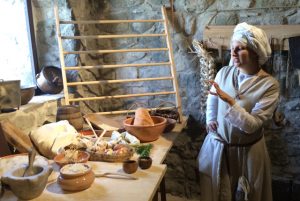
E se tanto abbiamo parlato di vita quotidiana, non possiamo esimerci dal tirare in ballo la storia istituzionale, con riferimento specifico alla complessa, affascinante e articolata storia del sito di Verrucole. Migliaia di anni di storia non possono essere riassunti in poche righe, ed è importante dare rilievo al periodo di dominazione estense, iniziato nel XV sec., che ha contribuito fortemente all’aspetto attuale della struttura. La storia delle Verrucole è difficile da leggere, e bisogna fare attenzione a non far confusione anche lessicale tra i termini castello e fortezza. Generalizzando, possiamo parlare di una Fortezza (termine appropriato per la struttura attuale, approntata dal XV sec. per uso esclusivamente militare), nato da un Castello (insediamento contenente un villaggio civile), così com’era quando i Gherandinghi approntarono la prima Roca. E se volessimo si potrebbe tornare ancora indietro nel tempo …
Since we have talked a little bit about daily life, we would also like to mention some of the fascinating and complex histories of the Verrucole site. Thousands of years of history can not possibly be summarized in a few lines, and it is important to emphasize the period of domination by the Este, which began in the fifteenth century and which has contributed greatly to its present structure. The story Verrucole is hard to read, and you have to be careful not to get confused even among the lexical terms castle and fortress. Generalizing, we can speak of a Fortress (the appropriate term for the current structure, prepared by the fifteenth century. For military use only), born from a Castle (settlement containing a village), as it was when they prepared the first Gherandinghi Roca.
Non è nostra intenzione far qui un saggio sulla vita nel medioevo o sulla storia della Fortezza, ma solo trasmettere la nostra passione per la ricerca e istigare i lettori ad approfondire la propria conoscenza di tali argomenti. Ai più curiosi, consigliamo alcuni autori, grandi nomi indiscussi del medievismo: J. Le Goff; F. Cardini; M. Muzzarelli; A. Barbero.
It is not our intention here to make an essay on life in the Middle Ages or the history of the fortress, but only pass on our passion for research and incite readers to deepen their knowledge of these topics. For the curious, some authors suggest big names undisputed Medievalists: J. Le Goff; F. Cardini; M.
E ovviamente, concludiamo col il più caldo degli inviti di venire a trovarci e scoprire la ricchezza infinita della “banale storia di tutti i giorni” del medievale.
And of course, we conclude with the warmest of invitations to come and visit us and discover the infinite wealth of “the ordinary history of everyday life” in the middle ages.
Grazie Giulia! To Listen to the Podcast about the Verrucole Fortress: To read the original pod cast post and for a transcript of the text click here
(Right-click and choose “Save as…” to download to your device.)

